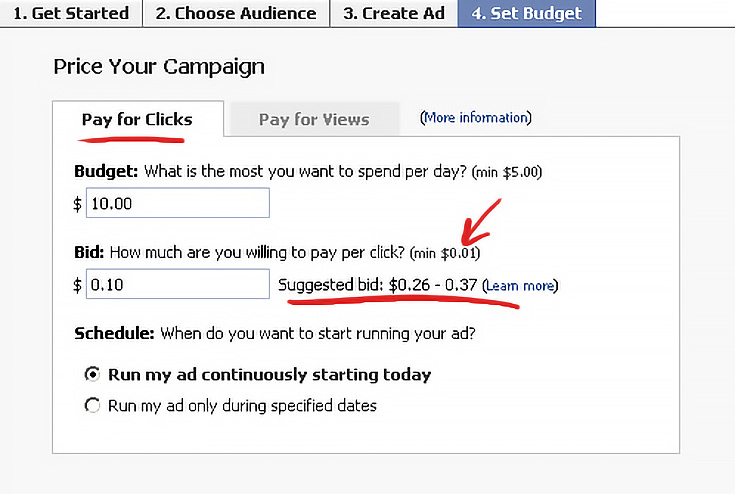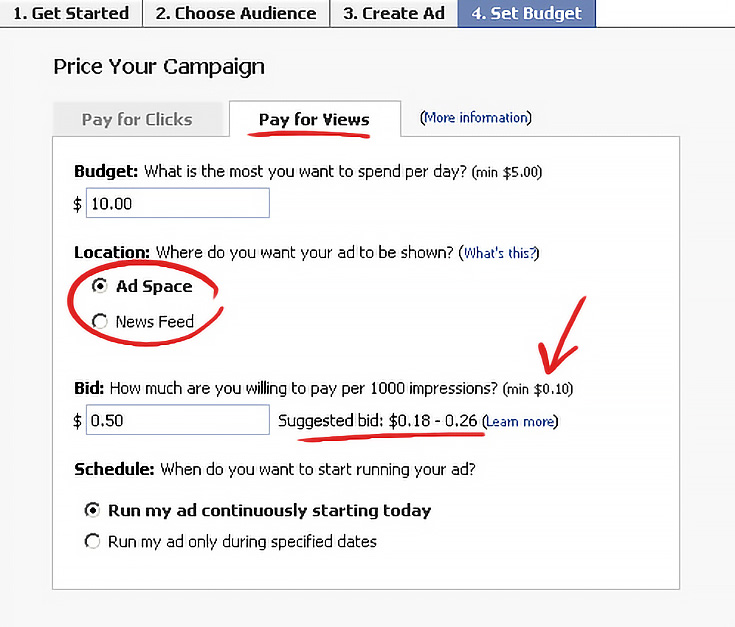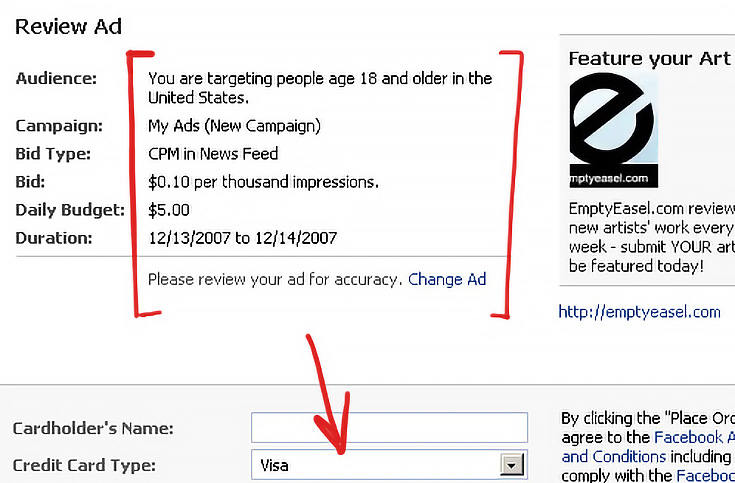Last week I posted an article explaining how artists could target art buyers through Facebook’s new advertising program. I only got half-way through the entire ad process in that article, so today I think I’ll just start in right where I left off—the part where you have to actually write the ad.
Remember, at this point you’ve already targeted a certain group of Facebook users— preferably ones that like art. Here’s the screen that pops up next.
As you can see, every Facebook ad needs a title and a body. The title is limited to 25 characters and the body is limited to 130 characters. You can also upload an image if you’d like, which I’d generally recommend.
Now for the tricky part. . . what to write?
Well, after drawing on my (admittedly limited) education in marketing and combing the internet for information, I came up with a few tips for writing compelling ads.
1. Use words in your title that strongly resonate with your audience. Facebook already makes it easy to figure out what those words are—after all, you just targeted a certain group of people by their interest, location, or age. Start with those words first so that your audience immediately connects with your ad.
2. Personalize the ad. Let your audience see YOU through it. If your ad looks and sounds like any other ad, people are more likely to tune it out. You might even upload a picture of yourself to show you’re a real person.
(That’s not my idea, by the way—Ed Terpening came up with it and also wrote this excellent article about his results.)
3. Use a clear call to action. I’ve read (and heard) that adding phrases like “click here,” “check it out,” or “learn more” can greatly increase click-throughs on an ad. Using that kind of language simply plants a seed in the viewers’ mind that there’s something more that they need to do, whether it’s click, call, or email.
4. Be as clear as possible in your ads. The ultimate goal is not to get clicks, but to sell more art—remember, it costs you money each time your ad compels people to click but doesn’t live up to its promises. So one way of writing ads is to try to weed out people who don’t intend to buy. Putting your prices up, perhaps?
Here’s a demo ad I put together for EmptyEasel to give you an idea of what I’m talking about. (Notice that images are limited to 110×80 pixels—make sure to resize before you upload so they don’t get distorted.)
For my first attempt, I started off with a title that I thought would grab artists’ attention and a strong call to action in the body paragraph:
“Feature your Art! EmptyEasel.com reviews new artists’ work every week—submit YOUR art to be featured today!”
Unfortunately Facebook doesn’t allow exclamation points in the titles, so the end result is a little less powerful than I’d hoped for.
If I wanted to personalize it more, I might say something like this instead:
“Are you an artist? Last week Alex Garcia’s paintings were featured on EE—contact me if you’d like to be featured too!”
There are a lot of ways you can go, and it’s only by trial and error that you’ll see which type of ad works best. Once you’re at least somewhat satisfied with the wording of your ad, click “continue” to set up your budget.
You’ve got two main options at this point—choose to pay a little bit of money every time someone clicks on your ad, or choose to pay a little bit of money every thousand times your ad is displayed.
There are other little choices too: how much to spend each day, how much you want to bid, when you want your ad to run, and even WHERE you want your ad to run (if you’re paying per 1000 impressions, anyway.)
Facebook will offer suggestions on how much you should bid, but the bid amount is entirely up to you. Just keep in mind that if another advertiser pays more than you do per click or impression, Facebook will display their ad instead of yours.
And although I admit I don’t know as much about ad pricing techniques as I’d like to, I do know this: if you’re getting a high percentage of clicks per views (say 10%) and paying 20 cents per click, you might be better off paying per thousand views instead.
Why? Because by the time you get to 1000 impressions you’ve just paid for 100 clicks and that’s $20 bucks. At that point you could probably pay less money for a thousand views, get the same amount of clicks, and save a lot of cash.
Of course, it goes both ways. . . if you’re bidding $5 for 1000 impressions and only get a few clicks, you’d be better off paying 20 cents per click.
Whew. Got all that?
Here’s the final screen before your ad goes live—just check to make sure the ad information is correct, fill out your credit card details, and agree to Facebook’s terms.
And that’s it, you’re done! Facebook has some nifty stats to keep track of your ad campaigns, but I think I’ll save that post for another day.
Hopefully this article has helped you understand Facebook ads a little better, and if you decide to take the plunge, let me know. I’d love to hear how it’s working for you.
This post may contain affiliate links.





